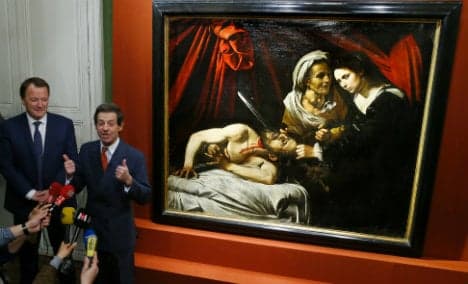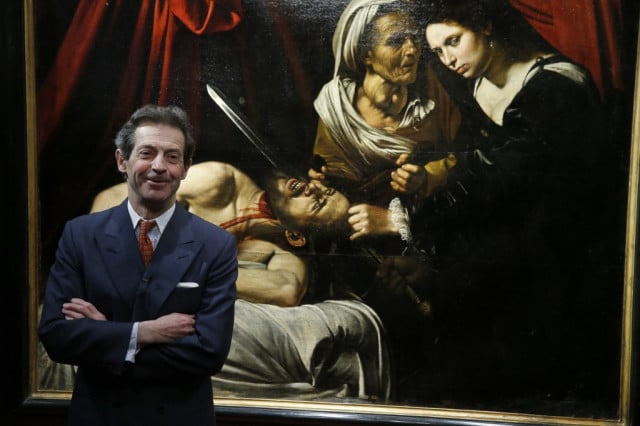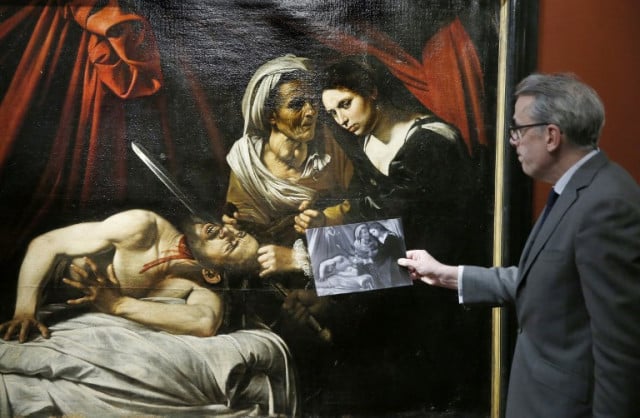Art expert stakes reputation on 'lost' Caravaggio painting

France's leading authority on Old Masters paintings says Italian critics are wrong to doubt the authenticity of the controversial 'attic Caravaggio'.
Art expert Eric Turquin is not only convinced that a canvas found in the attic of an old house in southwest France is a Caravaggio - he believes it is a revolutionary masterpiece.
France's leading authority on Old Masters paintings has staked his reputation on the assertion that the work is the fiery Italian artist's lost "Judith and Holofernes".
The painting depicting a grisly biblical scene of the beautiful Jewish widow Judith beheading a sleeping Assyrian general will be displayed in Paris on Friday before it goes under the hammer on June 27 in Toulouse, the city where it was discovered five years ago.

Art expert Eric Turquin stands in front of the painting in 2016. Photo: AFP
Turquin said it should sell for between 100 and 150 million euros.
"Not only is it a Caravaggio, but of all the Caravaggios that are known today, this is one of the great pictures," he insisted.
"The painting is in an extraordinarily good state, much better than the Caravaggios I have seen in Naples," he told AFP.
But although everyone agrees on the quality of the work, a minority of experts - particularly in Italy - have their doubts.
They believe it is a copy made by the Flemish artist Louis Finson, who worked alongside Caravaggio as he painted.
But Turquin is adamant it is the original from 1606 whose existence was first noted in letters between Italian dukes and art dealers four centuries ago.
'Turning point'
He is more convinced than ever since the canvas was cleaned in January, a process that took three weeks. On top of X-rays, the cleaning "has shown that the painting was changed a lot as it was painted, with lots of retouching. That proves it is an original," Turquin said.
"Copyists don't make changes like that, they copy," he added.
A less virtuoso version of the scene by Finson hangs at the Palazzo Zevallos in Naples.
Standing in front of what has been called the "Toulouse Caravaggio" in a strongroom above his Paris office, Turquin showed the telltale trace of how the artist had changed his mind about which way Judith should be looking.

An art expert holds up a radiography of the disputed painting. Photo: Patrick Kovarik/AFP
"After five years of reflection, no one has put up a counter-argument," said the expert, accusing the Italian doubters of "pronouncing against the painting without seeing it.
"They say it's impossible because Caravaggio painted (no more than) 65 canvases... For them the history of art is set."
Turquin said the painting marked a turning point in Caravaggio's development as an artist.
The fiercely original painter had created his first canvas on the theme, the far more formal "Judith Beheading Holofernes" in 1598, which hangs at the Palazzo Barberini in Rome.
READ ALSO: Police back on the trail of ‘world's most wanted' stolen Caravaggio painting
But by 1606 Caravaggio's life had changed dramatically, and he was on the run for murder. He fled to Naples after being condemned to death for stabbing a man in a street brawl in Rome.
"He was painting faster, more spontaneously and more strikingly," said Turquin, adding that the painting reflects his now darker view of life.
"In one place, he made a brushstroke nearly a metre long. He did Judith's sleeve and the lace on it in one go. He was a virtuoso with the paintbrush.
"He changed his style, painting 'risparmio' (sparingly), using the black background and painting accentuating strokes onto it. This is particularly visible on the sheet."
Other experts have speculated that Finson could have added his own touches to the canvas after Caravaggio left suddenly for Malta in 1607, where he hoped he might be safer from his enemies.
Turquin said that he kept the "Toulouse Caravaggio" in his bedroom for 16 months "while art historians, insurers and restorers came to view it.
"We wanted to wait until we were sure before coming forward" and announcing the discovery to the world in April 2016 after the Italian Caravaggio expert Nicola Spinosa also gave it his imprimatur.
The painting will be sold in Toulouse by Marc Labarbe, the provincial auctioneer who discovered it after a local family asked him to value some "old things in the attic" of a house they were clearing.
The family -- who have not been named -- believe it may have been brought to France by one of their ancestors, an officer in Napoleon's army.
The Corsican invaded the then Kingdom of Naples in 1806 and put his brother Joseph on the throne.
Comments
See Also

Art expert Eric Turquin stands in front of the painting in 2016. Photo: AFP
Turquin said it should sell for between 100 and 150 million euros.
"Not only is it a Caravaggio, but of all the Caravaggios that are known today, this is one of the great pictures," he insisted.
"The painting is in an extraordinarily good state, much better than the Caravaggios I have seen in Naples," he told AFP.
But although everyone agrees on the quality of the work, a minority of experts - particularly in Italy - have their doubts.
They believe it is a copy made by the Flemish artist Louis Finson, who worked alongside Caravaggio as he painted.
But Turquin is adamant it is the original from 1606 whose existence was first noted in letters between Italian dukes and art dealers four centuries ago.
'Turning point'
He is more convinced than ever since the canvas was cleaned in January, a process that took three weeks. On top of X-rays, the cleaning "has shown that the painting was changed a lot as it was painted, with lots of retouching. That proves it is an original," Turquin said.
"Copyists don't make changes like that, they copy," he added.
A less virtuoso version of the scene by Finson hangs at the Palazzo Zevallos in Naples.
Standing in front of what has been called the "Toulouse Caravaggio" in a strongroom above his Paris office, Turquin showed the telltale trace of how the artist had changed his mind about which way Judith should be looking.

An art expert holds up a radiography of the disputed painting. Photo: Patrick Kovarik/AFP
"After five years of reflection, no one has put up a counter-argument," said the expert, accusing the Italian doubters of "pronouncing against the painting without seeing it.
"They say it's impossible because Caravaggio painted (no more than) 65 canvases... For them the history of art is set."
Turquin said the painting marked a turning point in Caravaggio's development as an artist.
The fiercely original painter had created his first canvas on the theme, the far more formal "Judith Beheading Holofernes" in 1598, which hangs at the Palazzo Barberini in Rome.
READ ALSO: Police back on the trail of ‘world's most wanted' stolen Caravaggio painting
But by 1606 Caravaggio's life had changed dramatically, and he was on the run for murder. He fled to Naples after being condemned to death for stabbing a man in a street brawl in Rome.
"He was painting faster, more spontaneously and more strikingly," said Turquin, adding that the painting reflects his now darker view of life.
"In one place, he made a brushstroke nearly a metre long. He did Judith's sleeve and the lace on it in one go. He was a virtuoso with the paintbrush.
"He changed his style, painting 'risparmio' (sparingly), using the black background and painting accentuating strokes onto it. This is particularly visible on the sheet."
Other experts have speculated that Finson could have added his own touches to the canvas after Caravaggio left suddenly for Malta in 1607, where he hoped he might be safer from his enemies.
Turquin said that he kept the "Toulouse Caravaggio" in his bedroom for 16 months "while art historians, insurers and restorers came to view it.
"We wanted to wait until we were sure before coming forward" and announcing the discovery to the world in April 2016 after the Italian Caravaggio expert Nicola Spinosa also gave it his imprimatur.
The painting will be sold in Toulouse by Marc Labarbe, the provincial auctioneer who discovered it after a local family asked him to value some "old things in the attic" of a house they were clearing.
The family -- who have not been named -- believe it may have been brought to France by one of their ancestors, an officer in Napoleon's army.
The Corsican invaded the then Kingdom of Naples in 1806 and put his brother Joseph on the throne.
Join the conversation in our comments section below. Share your own views and experience and if you have a question or suggestion for our journalists then email us at [email protected].
Please keep comments civil, constructive and on topic – and make sure to read our terms of use before getting involved.
Please log in here to leave a comment.